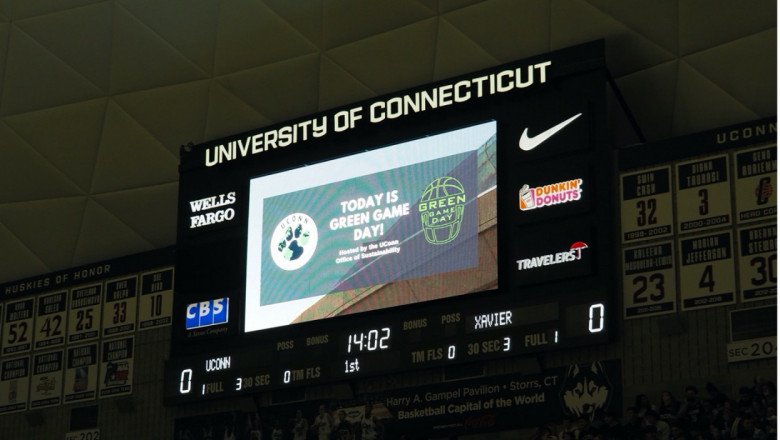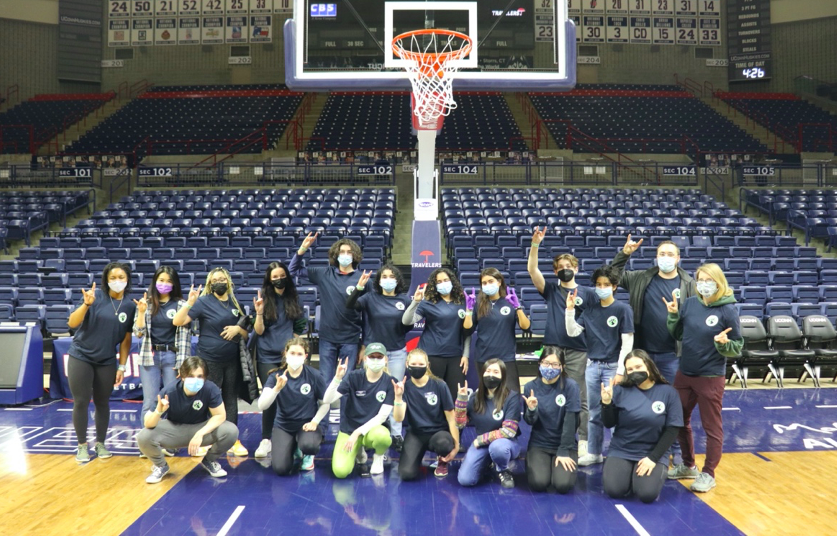
Each basketball season, UConn's Office of Sustainability and UConn Athletics partner to host a Green Game Day at Gampel Pavilion to promote recycling and engage with the community. (Maggie Singman)

Each basketball season, UConn's Office of Sustainability and UConn Athletics partner to host a Green Game Day at Gampel Pavilion to promote recycling and engage with the community. (Maggie Singman)
STORRS, Conn. – Colleges and universities across the United States are following the United Nations Sports for Climate Action initiative to address climate change effects caused by large scale collegiate athletics events and programs. A few institutions have already implemented sustainable athletic programs to prevent any further environmental harm.
The University of Connecticut is next in line to create a new Green Athletics program, currently developing in the Office of Sustainability, which partners with UConn Athletics for zero-waste and educational initiatives.
Green Athletics will be a program where institutions leverage their high-profile athletic programs and events to improve campus sustainability and engage their community with sustainability challenges and solutions. This program’s guidelines are provided by the Association for the Advancement of Sustainability in Higher Education, or AASHE.
The proposal will be delivered to stakeholders including the UConn Student-Athlete Advisory Committee (SAAC), athletic staff, and different sustainability organizations across campus. Intern Sydney Seldon, a sophomore environmental science major, is leading the development of the proposal to elevate this partnership. A request to present in the near future has been sent to SAAC, but a date has not been set.
“We would address the progress we’ve already made in some of these areas and also address the progress that still needs to be made,” Seldon said.
The Office of Sustainability’s creation of a Green Athletics program will contribute to the University’s 2020 Vision for Campus Sustainability and Climate Leadership. It is significant that athletics capitalizes on this vision because of its large audience and presence on campus. “This is important at UConn because it can not only achieve the goals that UConn has already set but also provides the opportunity for the restoration and reform of the many communities that have supported UConn for generations,” Seldon said.
The proposal consists of different criteria provided by AASHE. It includes zero-waste athletic events, community engagement, and an athletic team certification program. Green Game Day is an event already implemented that puts UConn on track to create the program.
Since 2008, UConn Athletics and the Office of Sustainability have held a Green Game Day every season for football, men’s basketball, and women’s basketball. “Between our areas, we have a group of volunteers who staff a table at these games to engage fans on recycling and sustainable living,” said Tysen Kendig, vice president of communications for UConn Athletics. “We also do special programming during the game on the video boards to promote recycling, and some trivia and facts provided by the sustainability office that is interspersed during the game.”
The Green Game Days at Gampel Pavilion in 2020 qualified as carbon neutral because offsets were purchased to mitigate emissions caused by the games. College athletics generate emissions in many ways such as building operations, travel, waste processing, landscaping, and more. According to the Harvard Law School Climate Solutions Living Lab, an example of an annual emission inventory for a university athletics department is 6,800 tonnes CO2. Building operations and landscaping make up 77% of those emissions.

Green Game Day events are held at Gampel Pavilion and Pratt & Whitney Stadium in East Hartford. At the last Green Game Day football game on Sept. 10, Seldon and other volunteers went to the tailgates and collected recyclables. Because the stadium only supplies attendees with trashcans as waste receptacles, the volunteers had to supply recycling bins and actively direct fans toward them. Although Pratt & Whitney Stadium is not UConn’s property, Seldon wants to create a more permanent relationship.
“It takes a lot of communication and relationship building, but that’s a goal in order to get more permanent recycling bins and educational signage there,” Seldon said.
Seldon hopes to follow in the footsteps of many other universities such as the University of Miami, which has successfully implemented a Green Athletics Program. The University of Southern California is another example of a program with recent success. During the 2021-22 seasons, USC won the Pac-12 Zero Waste Challenge in football and basketball by diverting over 90% of game-day waste from landfills, according to the USC Athletics website.
“They’ve done amazing things with their athletic programs. Of course, USC and UMass Lowell … recently joined the Green Sports Alliance. So, we hope to look to these other schools for inspiration and guidance,” Seldon said.
Seldon plans to incorporate waste-diversion rates and tracking in the proposal. Currently, the Office of Sustainability does not have access to this information. “UConn does not organize its waste in terms of how much waste Gampel produces or how much the ice hockey arena produces,” Seldon said. “Everything goes to the same trash bins so it’s hard to track how much waste Gampel normally produces.”
While the Green Athletics program is just now developing, there are other criteria under AASHE that UConn previously established. A green building rating system, LEED, was adopted in 2016 to ensure sustainable practices are used during the planning, design, and construction of UConn buildings costing more than $5 million. UConn LEED projects receive a rating of either certified, silver, gold or platinum based on various points earned across several categories. Features that contribute to a rating can include energy-saving windows, low-flow faucets, high-performance insulation, and the use of renewable and recycled materials.
In the proposal, Seldon says that the new Toscano Family Ice Forum will be LEED certified. Buildings on campus already LEED-recognized are the Burton-Shenkman Football Complex and Basketball Practice Facility. According to UConn’s Office of Sustainability, the football complex has dual-flush toilets, lockers made from recycled content, Green-Label carpet, and 89% of its construction waste was recycled.
The proposal includes plans to provide more sustainable vendor options, like using compostable containers in the stadiums. Although, these plans do present challenges for UConn Athletics during their efforts to reduce spending. Sustainable products used in concessions and vendors would be more expensive.
“Being greener is a worthwhile and important endeavor, so we continue to work with vendors on cost-effective options to provide a more environmentally friendly fan environment,” Kendig said.
Student-Athlete engagement is an important component of the Green Athletics mission. The program strives to promote climate leadership at UConn and get student-athletes involved as much as possible.
“We want to provide athletes an opportunity to get involved in things that they may really care about or maybe haven’t even heard of,” Seldon said. “There are really good discussions going on between athletes, the student body and organizations who are involved in this kind of work.”